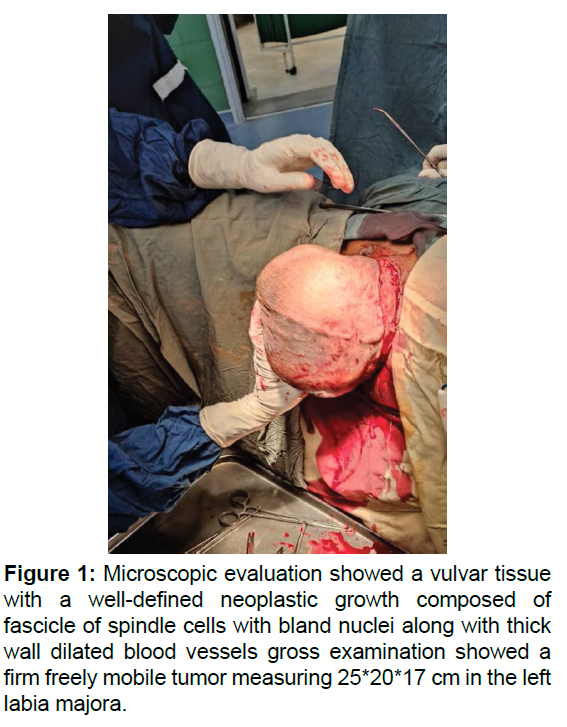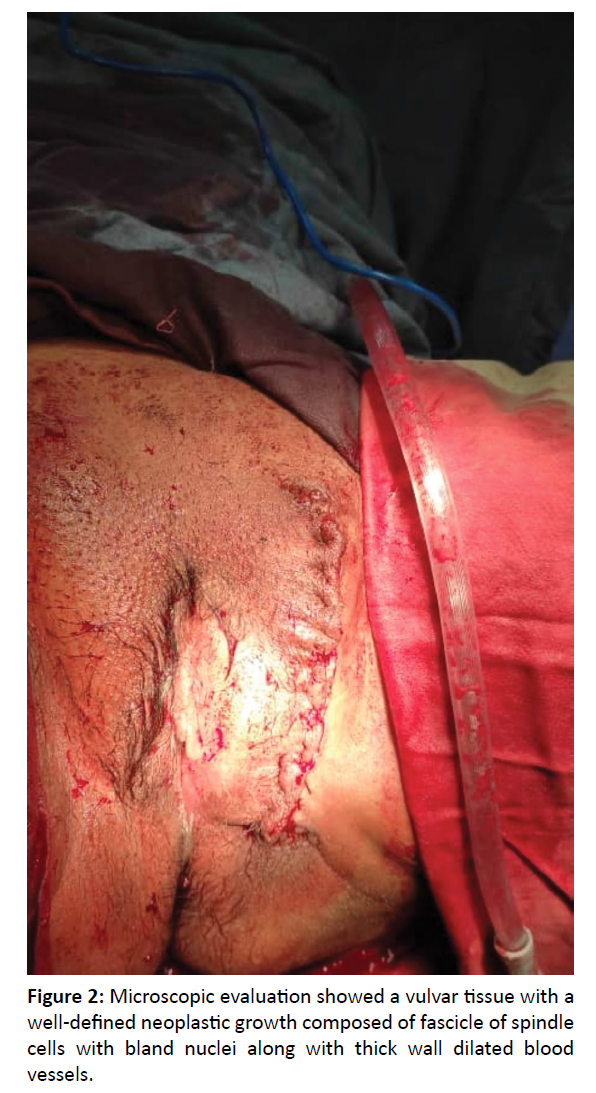Case Report - (2022) Volume 8, Issue 3
A Giant Pedunculated Vulvar Lesion: A Case Report
Pegah Arfae and
Zahra Honarvar*
Department of Obstetrics and Gynecology, Kerman University of Medical Sciences, Iran
*Correspondence:
Zahra Honarvar, Department of Obstetrics and Gynecology, Kerman University of Medical Sciences,
Iran,
Email:
Received: 06-Feb-2022, Manuscript No. IPGOCR-22-12463;
Editor assigned: 08-Feb-2022, Pre QC No. P-12463;
Reviewed: 20-Feb-2022, QC No. Q-12463;
Revised: 17-Mar-2022, Manuscript No. R-12463;
Published:
24-Mar-2022, DOI: 10.21767/2471-8165.1000012
Abstract
Angiofibroma is a benign mesenchymal tumor. Its clinical presentation is nonspecific and similar to other vulvar
tumors. Angiofibroma has good prognosis, despite some risk of recurrence. We present a 44-year-old woman
with a bulky left vulvar lesion.
Keywords
Angiofibroma; Mesenchymal; Tumor; Vulva
Introduction
Angiofibroma is a soft tissue tumor that occurs in vulvo vaginal
region in females and inguino-scrotal region in males [1].
These tumors are well-circumscribed, superficial and include
soft spindle cells and veins [2]. It is first described by Nucci MR,
et al. [1] in 1997 in a series of 6 cases that occurred almost in
the vulvar region of middle- aged women.
Since the first description by Nucci, few studies have been
published about this kind of lesion in the literature. According
to studies, there is no known risk factor for angiofibroma.
Case Presentation
We present an unusual case of pedunculated angiofibroma
mass. A healthy virgin 44-year-old woman consulted for a
painless vulvar mass. There was no previous infection or
bleeding. The patient history revealed that the mass was first
identified four years earlier and it had gradually enlarged. It
caused discomfort when sitting or walking due to its size. Gross
examination showed a firm freely mobile tumor measuring
25*20*17 cm in the left labia majora (Figure 1).

Figure 1: Microscopic evaluation showed a vulvar tissue
with a well-defined neoplastic growth composed of
fascicle of spindle cells with bland nuclei along with thick
wall dilated blood vessels gross examination showed a
firm freely mobile tumor measuring 25*20*17 cm in the left
labia majora.
There was no family history of cancer. She didn’t report any
use of Oral Contraceptive Pills (OCP) or hormone replacement therapy. The patient gynecological examination was normal
and no palpable inguinal lymph nodes were distinguished.
The patient underwent surgery with a diagnosis of vulvar mass.
The mass was composed of large vessels and after resection
had 3 kgs weight. Microscopic evaluation showed a vulvar
tissue with a well-defined neoplastic growth composed of
fascicle of spindle cells with bland nuclei along with thick wall
dilated blood vessels (Figure 2).

Figure 2: Microscopic evaluation showed a vulvar tissue with a
well-defined neoplastic growth composed of fascicle of spindle
cells with bland nuclei along with thick wall dilated blood
vessels.
Discussion
Angiofibroma is considered benign. Surgical excision of the
lesion seems to be the adequate management [3], not only to treat the patient but also to achieve a correct diagnosis. The
potential recurrence risk of these lesions is low [4].
However, Mc Cluggage WG, et al. [5] reported one case of
recurrence in a 49-year-old woman that occurred 6 months
after excision.
Angiofibroma should be considered in the differential diagnosis
of painless soft masses that may reach large dimensions in the
vulva [6].
The present case is the largest angiofibroma defined in the
literature.
There are many mesenchymal tumors which enter into the
differential diagnosis with angiofibroma as spindle cell lipoma,
solitary fibrous tumor, mammary myofibroblastoma, angiomyofibroblastoma,
aggressive angiomyxoma and smooth
muscle tumor. All these described tumors share similar morphologic
features and are characterized by bland ovoid to spindle
shaped cells with wispy collagen; vaiably sized thich- walled
blood vessels [7].
Conclusion
In summary, Pathologists should be aware of morphological
variation to avoid diagnostic errors and therefore an aggressive
treatment. Angiofibroma in women represents a benign lesion,
so a treatment of simple local excision of the lesion is adequate.
REFERENCES
- Nucci MR, Granter SR, Fletcher CD (1997) Cellular angiofibroma: a benign neoplasm distinct from angiomyo fibroblastoma and spindle cell lipoma. Am J Surg Pathol 21(6): 636-644.
[Google Scholar], [Crossref], [Indexed at]
- Chen E, Fletcher CDM (2010) Cellular angiofibroma with Atypia or sarcomatous transformation: clinicopathologic analysis of 13 cases. Am J Surg Pathol 34(5): 707-714.
[Google Scholar], [Crossref], [Indexed at]
- Kumar P, Singh S, Kumar A, Janoria S (2018) A rare case of cellular angiofibroma affecting the periurethral region in a 38-year-old woman. BMJ Case Rep 2018: 225386.
[Google Scholar], [Crossref], [Indexed at]
- Khmou M, Lamalmi N, Malihy A, Rouas L, Alhamany Z (2016) Cellular angiofibroma of the vulva: a poorly known entity, a case report and literature review. BMC Clin Pathol 16(1): 8.
[Google Scholar], [Crossref], [Indexed at]
- Mc Cluggage WG, Perenyei M, Irwin ST (2002) Recurrent cellular angiofibroma of the vulva. J Clin Pathol 55(6): 477-479.
[Google Scholar], [Crossref], [Indexed at]
- Umit A, Hasan T, Unal T, Ahmet TE, Ahmet KA (2016) Giant Vulvar Mass: A Case Study of Cellular Angiofibroma. Hindawi Case Rep Obstet Gynecol 2016: 2094818.
[Google Scholar], [Crossref], [Indexed at]
- Micheletti AM, Silva AC, Nascimento AG, Da Silva CS, Murta EF, et al. (2005) Cellular angiofibroma of the vulva: case report with clinic pathological and immunohistochemistry study. Sao Paulo Med J 123(5): 250-252.
[Google Scholar], [Crossref]
Citation: Arfae P, Honarvar Z (2022) A Giant Pedunculated Vulvar Lesion: A Case Report. Gynecol Obstet Case Rep. Vol.8 No.3:12. DOI: 10.21767/2471-8165.1000012
Copyright: © 2022 Arfae P, et al. This is an open-access article distributed under the terms of the Creative Commons Attribution License, which permits unrestricted use, distribution, and reproduction in any medium, provided the original author and source are credited.



